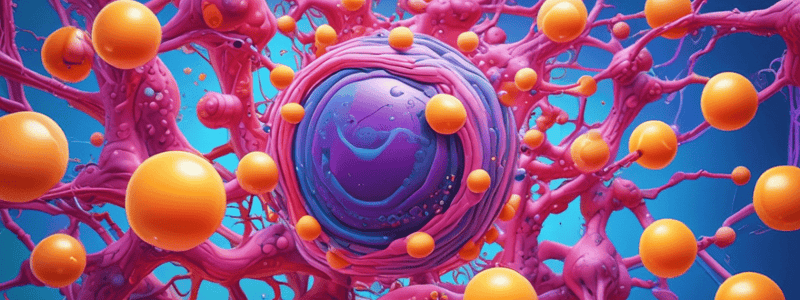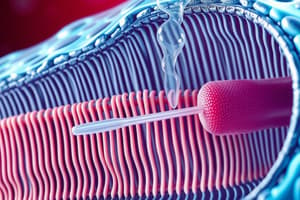Podcast
Questions and Answers
What is the main characteristic of facilitated diffusion?
What is the main characteristic of facilitated diffusion?
- Molecules move through pores in channel proteins (correct)
- Carrier proteins change shape
- Moves molecules from low to high concentration
- Requires energy or ATP
How do carrier proteins assist in moving molecules across the cell membrane?
How do carrier proteins assist in moving molecules across the cell membrane?
- Undergoing conformational changes
- Extending through the membrane
- Creating a membrane potential
- Bonding, dragging molecules through the lipid bilayer, and releasing them on the opposite side (correct)
Which type of transport requires energy or ATP?
Which type of transport requires energy or ATP?
- Secondary active transport
- Facilitated diffusion
- Symport
- Primary active transport (correct)
What is the function of the sodium-potassium pump?
What is the function of the sodium-potassium pump?
In primary active transport, where does the energy come from for the functions of carrier proteins?
In primary active transport, where does the energy come from for the functions of carrier proteins?
What is the term used for coupled transport when another molecule is moved in the same direction as Na+?
What is the term used for coupled transport when another molecule is moved in the same direction as Na+?
What process is involved in the correction of YD's hyperkalemia during dialysis?
What process is involved in the correction of YD's hyperkalemia during dialysis?
Which compartment had the higher concentration of potassium in YD's case?
Which compartment had the higher concentration of potassium in YD's case?
What is the purpose of the semipermeable membrane in the hemodialysis filter?
What is the purpose of the semipermeable membrane in the hemodialysis filter?
How did the concentration gradient help correct YD's hyperkalemia?
How did the concentration gradient help correct YD's hyperkalemia?
Which fluid had a lower potassium concentration in YD's case?
Which fluid had a lower potassium concentration in YD's case?
What drives the force of diffusion during simple diffusion?
What drives the force of diffusion during simple diffusion?
Which molecule can easily pass through the cell membrane via simple diffusion?
Which molecule can easily pass through the cell membrane via simple diffusion?
In which solution is there no net movement of water molecules?
In which solution is there no net movement of water molecules?
What is the main characteristic of facilitated diffusion?
What is the main characteristic of facilitated diffusion?
What is the driving factor for osmosis?
What is the driving factor for osmosis?
What type of molecules are typically impermeable to the cell membrane in simple diffusion?
What type of molecules are typically impermeable to the cell membrane in simple diffusion?
What is the primary function of homeostasis?
What is the primary function of homeostasis?
Which of the following is NOT a factor that affects the rate of diffusion?
Which of the following is NOT a factor that affects the rate of diffusion?
What is the process called when water molecules move from a region of higher water concentration to a region of lower water concentration across a selectively permeable membrane?
What is the process called when water molecules move from a region of higher water concentration to a region of lower water concentration across a selectively permeable membrane?
Which of the following transport mechanisms requires the direct expenditure of energy by the cell?
Which of the following transport mechanisms requires the direct expenditure of energy by the cell?
In the clinical case presented, what process was involved in the correction of the patient's hyperkalemia during hemodialysis?
In the clinical case presented, what process was involved in the correction of the patient's hyperkalemia during hemodialysis?
Which of the following processes involves the formation of vesicles from the cell membrane?
Which of the following processes involves the formation of vesicles from the cell membrane?
What process is involved when a molecule or ion moves in the opposite direction to Na+ (out of the cell)?
What process is involved when a molecule or ion moves in the opposite direction to Na+ (out of the cell)?
Which process involves the movement of large molecules out of the cell through vesicles fusing with the plasma membrane?
Which process involves the movement of large molecules out of the cell through vesicles fusing with the plasma membrane?
In which process does the cell form an invagination to take in dissolved molecules?
In which process does the cell form an invagination to take in dissolved molecules?
Which process is used by cells to engulf large particles such as food or bacteria?
Which process is used by cells to engulf large particles such as food or bacteria?
In which process do integral proteins with receptors on their surface recognize and take in hormones or cholesterol?
In which process do integral proteins with receptors on their surface recognize and take in hormones or cholesterol?
What condition is the patient YD, a 62-year-old woman with type 2 diabetes mellitus, likely suffering from?
What condition is the patient YD, a 62-year-old woman with type 2 diabetes mellitus, likely suffering from?




